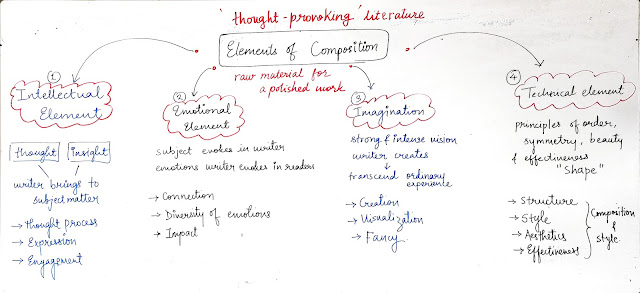Welcome Readers,
William Henry Hudson describes the elements of composition in literature by breaking them down into distinct categories, emphasizing both the raw materials provided by life and the unique contributions of the author.
1. Intellectual Element
The intellectual element refers to the thought and insight that the writer brings to their subject matter. It is the cognitive content of the literary work.
- Thought Process: It encompasses the writer’s ideas, arguments, reflections, and analysis regarding the subject. This can include philosophical musings, social commentary, or any form of intellectual exploration.
- Expression: The intellectual element is articulated through the narrative, dialogue, themes, and overall message of the work. It shapes the core substance of the literary piece.
- Engagement: Engaging the reader’s mind is a primary function of the intellectual element. It stimulates thought, provokes questions, and encourages deeper understanding of the subject matter.
2. Emotional Element
The emotional element is the feeling that the subject evokes in the writer and the emotions that the writer aims to evoke in the reader.
- Connection: Emotional content creates a bond between the writer and the reader. It allows readers to empathize with characters, situations, and the overall narrative.
- Diversity of Emotions: This element encompasses a wide range of emotions such as joy, sorrow, anger, fear, love, and nostalgia. It provides a dynamic and multifaceted reading experience.
- Impact: The emotional element is crucial for making the work memorable and impactful. It ensures that the reader is not just intellectually engaged but also emotionally invested.
3. Imagination
Imagination is the faculty of strong and intense vision that allows the writer to create vivid and compelling scenes, characters, and worlds. It also includes its lighter form, which is called fancy.
- Creation: Imagination is the source of creativity and originality in literature. It enables the writer to transcend ordinary experiences and craft unique and imaginative scenarios.
- Visualization: By exercising their imaginative powers, writers help readers to visualize and experience the world they have created. This immersive experience is a hallmark of compelling literature.
- Fancy: The lighter form of imagination, fancy, involves playful and whimsical creativity. It adds charm and a sense of wonder to the work, often seen in fantastical and surreal elements.
4. Technical Element (Composition and Style)
The technical element involves the principles of order, symmetry, beauty, and effectiveness used to shape and present the literary work. This includes the composition and style of the work.
- Structure: The technical element ensures that the literary work is well-organized and cohesive. This includes the plot structure, chapter divisions, and overall narrative flow.
- Style: Style encompasses the writer’s choice of language, diction, tone, and syntax. It gives the work its unique voice and character.
- Aesthetics: The principles of beauty and symmetry are applied to make the work pleasing to read. This includes rhythm in poetry, balanced prose, and harmonious composition.
- Effectiveness: The technical element ensures that the work effectively communicates its intellectual, emotional, and imaginative content. It enhances clarity, impact, and readability.
Conclusion
Hudson emphasizes that these elements—intellectual, emotional, imagination, and technical—work together to create the substance and life of literature. While each element plays a distinct role, they are interdependent and collectively contribute to the richness and depth of a literary work. A writer must skillfully balance these elements to produce a compelling and complete piece of literature.
Reference:
Hudson, William Henry. An introduction to the study of literature. Harrap, 1919.


Post a Comment